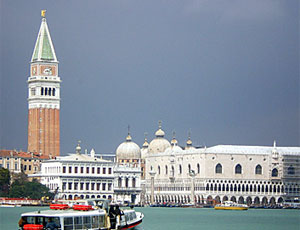A bell tower in St. Mark’s Square dating back to 12th-Century Venice is getting a new lease on life through a two-year project to stabilize the ill-fated monument standing on tricky soil. In January, workers began drilling cement-reinforced micro-piles to provide watertight enclosures around seven chambers so a girdle of titanium rods can be threaded through the ground around the tower’s faulty foundation block.

The most prominent monument in St. Mark’s Square in Venice is a 20th-Century reconstruction
During most of this year, subcontractor Trevi SpA, Cesena, will drill about 1,000 soil columns at the 4-meter-deep access pits that will penetrate 3 m into the water table, which occasionally has risen to flood the square.
With a single rig and about five workers, the contract is small, concedes Daniele Vanni, Trevi Group’s director of design, research and development. But the historic nature of the location and its tricky soil make it “special.”
The $15-million project is being handled by the large turnkey team of Consorzio Venezia Nuova. CVN is working to remedy a botched operation that tried to enlarge the foundations of a previous bell tower, which collapsed in 1902.
The original 12th-Century campanile was restored many times and was largely rebuilt in the 16th Century. But it was weakened by age and, according to local records, a structurally damaging lightning strike in 1745.
In 1902, it collapsed entirely, but it was rebuilt with a plan that nearly doubled the area of the original foundation block to about 410 sq m, thereby reducing ground pressure. Over 3,000 tree-trunk piles were driven around the original block, infilled with concrete; the entire foundation was topped with stonework.
However, according to CVN, the builders failed to make the new and old foundation sufficiently monolithic. That failure led to loads concentrating at the corners, causing differential settlement and cracking stonework. Today, the tower leans by about 7 cm over its roughly 100 m height.
The new round of remedial work will involve reinforcing the enlarged foundation by ringing it with two layers of stressed 6-cm-dia titanium rods in pairs. One level will be some 40 cm below the paving and the second about 2.3 m down.
Rods will be drilled through the soil and bolted together in lengths of 2 to 3 m. They will be anchored at the foundation’s corners by titanium plates and stressed to an initial 250 kilonewtons each, according to CVN engineers. Then, depending on the foundation’s structural responses, stresses will be progressively increased over a few years.
Rod sections and their forced-screw connections are being produced by Titalia Srl, located near Milan, using some 6 tonnes of metal shipped by Germany’s ThyssenKrupp Titanium GmbH., Essen, last year. Titanium costs about five times more than stainless steel, but “it has corrosion resistance for the next 1,000 years, if necessary...in seawater,” says Helmut Gost, Thyssen’s marketing manager.
Overall responsibility for the project lies with CVN. With dozens of member firms, the consortium has been charged by Venice Water Authority to deliver the lagoon’s flood barriers and protect key buildings and infrastructure.
Created in 1501, the authority is now part of the infrastructure ministry, the responsibilities of which include safeguarding the lagoon, the city of Venice and infrastructure of the wider region.
CVN assigned the tower project to a locally based consortium member, SACAIM S.p.A., which will...


Post a comment to this article
Report Abusive Comment